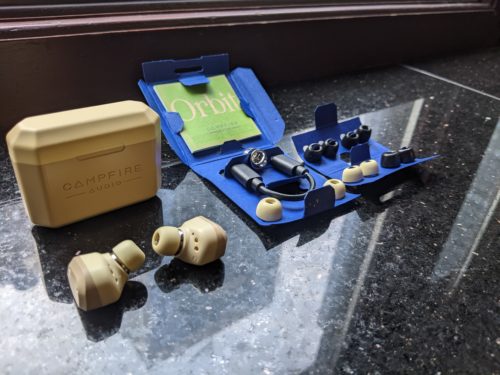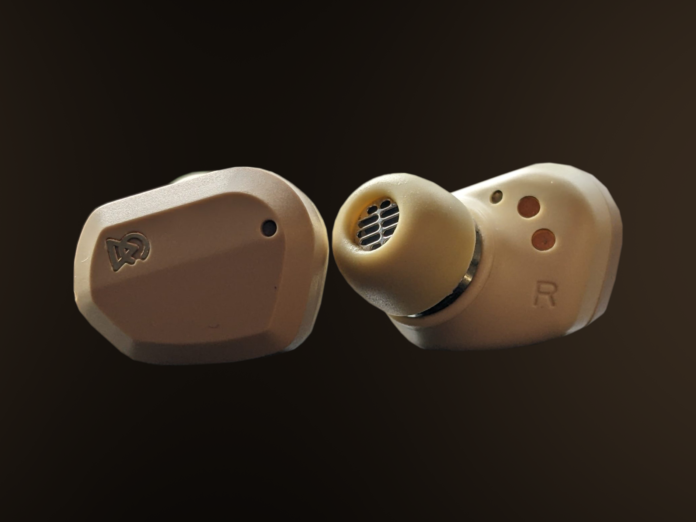Campfire Audio Orbit Review
It seems like every audio company these days is getting around to releasing a pair of $250 true wireless earbuds. The most recent company to throw its hat into this ring is Campfire Audio with their brand new wireless release: the Campfire Audio Orbit. I was surprised to hear about this release, as Campfire is usually associated with premium audiophile IEMs that are generally fairly expensive (and wired). I’m excited to see a well-regarded, somewhat boutique company make its foray into this competitive, casual-consumer-oriented space. Let’s go over some of the features and tech before we jump into what Campfire Audio’s Orbit sounds like.

What’s In The Box?
- Campfire Audio Orbit Wireless Earbuds
- Portable Charging Case
- 3 Pairs Silicone Eartips
- 3 Pairs Foam Eartips
- USBC charging Cable
- User Guide
- Campfire Audio Pin
Look and Feel
On a scale of AirPods to Samsung Galaxy buds, the Orbit’s fit is on the latter’s half of the spectrum. There’s no stem on them, and they instead rest squarely inside the bottom well of a listener’s concha. The acoustic nozzle is wide and designed to rest on the outer opening of the ear canal, or at the shallow start of it if you choose to use the foam tips. I would describe it as an “outer-in-ear” fit, and it isn’t uncommon to see on wireless buds. The thoughtful inclusion of foam tips provides quite a bit of extra grip for people like myself who prefer a more sealed-ear sensation that goes a little deeper into the ear canal. I also liked using the foam tips with the Orbit because they complimented the Orbit’s ear-sealing shape, which contributed to some excellent passive isolation. With its simple and shallow physical design, compact size, and light weight, the Orbit stayed in my ears for hours without any problems or adjustments. Some people may think the buds are chunky looking, but in my time with the unit, that characteristic wasn’t particularly relevant to how it actually fit in my ear.
Judge for yourself, but I really like the Orbit’s style. It’s modern, but not in an overly techy and kitschy way; it features warm forest colors with muted beige-brown and green details. In the context of the black-white-grey color scheme that gets imparted onto 99% of wireless buds, the Orbit stands out and may well be the coolest looking wireless bud that I’ve come across.

Bluetooth, Battery, App, Technical Specs
I tested Campfire Audio’s Orbit indoors and didn’t experience any random cut-outs or disconnections until I started venturing about 30 or 40 feet from my phone in an unobstructed path. This is about average range, and I’m happy with it. As for the mic, call clarity was pretty crisp and perfectly up to snuff.
The Campfire Audio app seems fairly simple, and is where you can make some EQ adjustments , turn on and off smart controls and check the Orbit’s battery level. The equalizer features 7 bands, and allows for 12dB of subtraction and 3dB of boost. When I went to use the EQ, I occasionally had some issues getting it to open. Granted, I’m using the app prior to its official release – perhaps by the time of release this issue will be resolved, so I’m not going to hold this against Campfire.
When I first paired the Orbit with my phone, audio came through only on the left side. Upon a quick and easy reset by holding down the button on the charging case while the buds were in it, I was able to seamlessly connect and didn’t experience any further problems. The only minor issue I found was that audio may briefly cut out if you’re adjusting the Orbit in your ears and your finger happens to cover to Bluetooth receiver on one of the buds. This issue isn’t specific to just the Orbit when it comes to wireless, and didn’t present itself very frequently. It’s not so much an annoyance as it is just something to be aware of.
Buds’ Battery Life: 8.5 Hours Playback @ 80% Volume
Case Battery: 30 Hours Total Playtime Reserve
Bluetooth: 5.2
Codecs: SBC, AAC, AptX Adaptive
Frequency Response: 5 Hz – 20 kHz
Smart Controls
- 1 Tap (L or R): Pause/Play
- 2 Tap (L): Previous Track
- 2 Tap (R): Next Track
- 3 Tap (L or R): Mic
Sound Stage
If you’re wondering where those special Campfire qualities come into play, you can find them pretty easily in the staging and imaging. It’s commonplace for wireless headphones or earbuds to present audio in a flat, left-right linearity. I can’t say this was the case with the Orbit. It surprised me with some moderate three dimensional qualities in its imaging. Certain panned parts were more striking than others, and gave me the “travelling-across-my-face” feeling that I get from high quality, wired IEMs. I even felt mono acoustic guitar transients on the top of my head, and hi hats felt situated just above the tips of my ears. This gets it a lot of points in my book, as it truly breaks the mold of expectations for wireless buds in this regard. To clarify: If you end up trying the Orbit, don’t expect vibrant spatial layering – you’re not going to find it in any wireless bud right now – but the Orbit seems to take a preliminary step in that direction, and is far in the lead comparatively to anything else like it. Its sound stage and imaging was easily what impressed me the most with the buds.
Lows
As is the case with most wireless audio, the Orbit’s sound signature is predominantly marked by a broadly boosted low end. Though it seemed to occasionally struggle with the definition and articulation of deep bass and subs, the highlight of the low end was a tight and powerful mid bass. Kick drums with short decays produced a surprising slam that I felt shoot to the back of my head. This quality was a solid compliment to the Orbit’s impressive imaging as it added not only impact, but an additional spatial element as well. High bass gave me some problems, but I’ll discuss that in context with the mids.
Mids
In general, high bass and low mids alike seemed a bit too prominent. At its best, this provided a smooth warmth on instruments. However, vocals were a common casualty in this balance, as their deeper fundamentals shot to the top of the mix and masked their realistic upper-mid overtones. I was waiting for high mids to kick in to provide some lift, which they did – maybe just a little too late. I had a bit of a hard time making sense of the general high-mid EQ, which left vocals sounding soft yet still expressed percussion with snappy qualities. Overall, the mids profile leaves the Orbit sounding soft with occasional moments of clear, impactful treble. I’m sure a lot of listener’s will like this warm and fuzzy tone, which is a common wireless timbre, but I couldn’t help but add 3dB to 2 kHz in the app, which kind of helped.
Highs
My gut feeling with the Orbit was that I wanted more energy in the high frequencies to lift its otherwise dense and dark balance. That being said, this is a criticism that I have for the vast majority of wireless buds, which seem to prioritize providing an easy-listening timbre and minimizing listening fatigue. So while my personal tastes leave me wishing for more air and lift, those who enjoy and are accustomed to the reserved high end frequency profiles on wireless buds aren’t going to hear much of a problem. Synths still contained their buzzy overtones, while hi-hats still have their crispy qualities, and even present with a trace sense of height in the image. While male vocals didn’t have very much air on them, I had some good luck when I was listening to The Sundays, where the Orbit was able to keep up with the rasp on the lead singers high pitched feminine voice. Once again, I found it helpful to boost the 12kHz and 14kHz EQ bands, and once again, it kind of helped get it closer to my preferences.

Overall
Though the Orbit’s mid bass was pretty impressive, the balance had a lot of wireless hallmarks and won’t sound unfamiliar to those who already have a pair around the $250 tier: Heavy lows, pronounced low mids, recessed treble. I would recommend the Orbit to somebody who places a lot of stock in sound stage, as I can honestly say that this was the best imaging experience I’ve had with a wireless bud, full stop. Campfire’s Orbit is really close to being something great, and it’s an impressive first release from a company that is delving into the wireless market for the first time. I have a feeling the next generation of wireless buds from Campfire could be game changing – the Orbit gave me glimpses of what the near future could have in store.
Campfire Audio’s Orbit is available for purchase from Audio46.
| Pros | Cons |
| Excellent imaging for wireless buds
Punchy mid bass with some slam Good passive isolation Solid Bluetooth connection Lightweight, comfortable, looks cool |
Overemphasis on vocal fundamentals
Quiet treble |
MAJORHIFI may receive commissions from retail offers.








